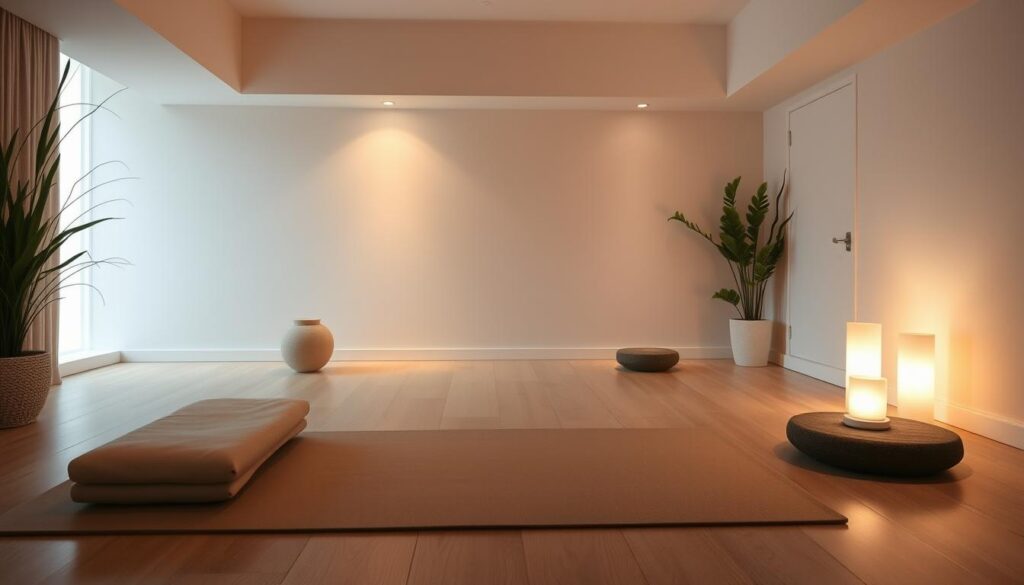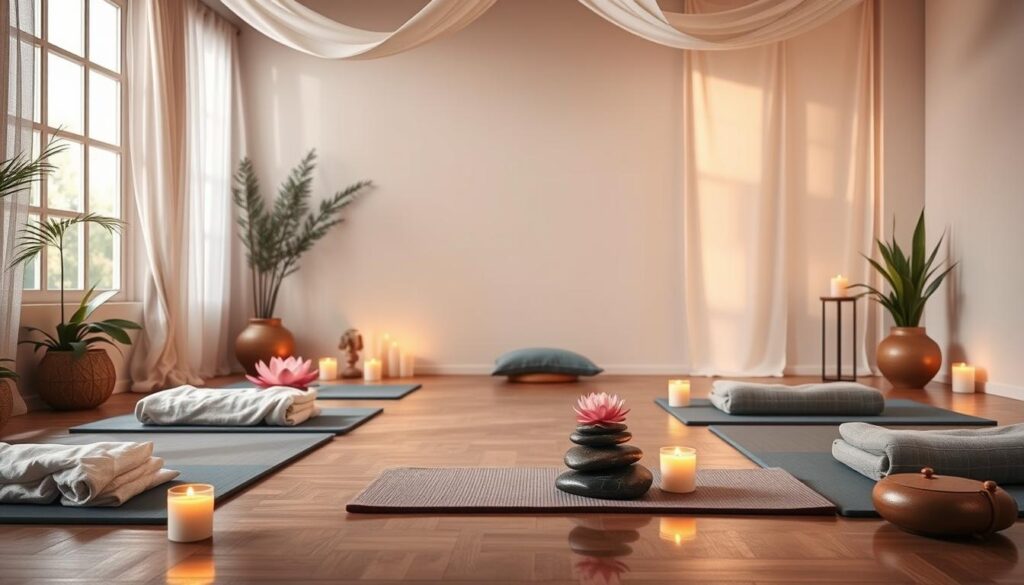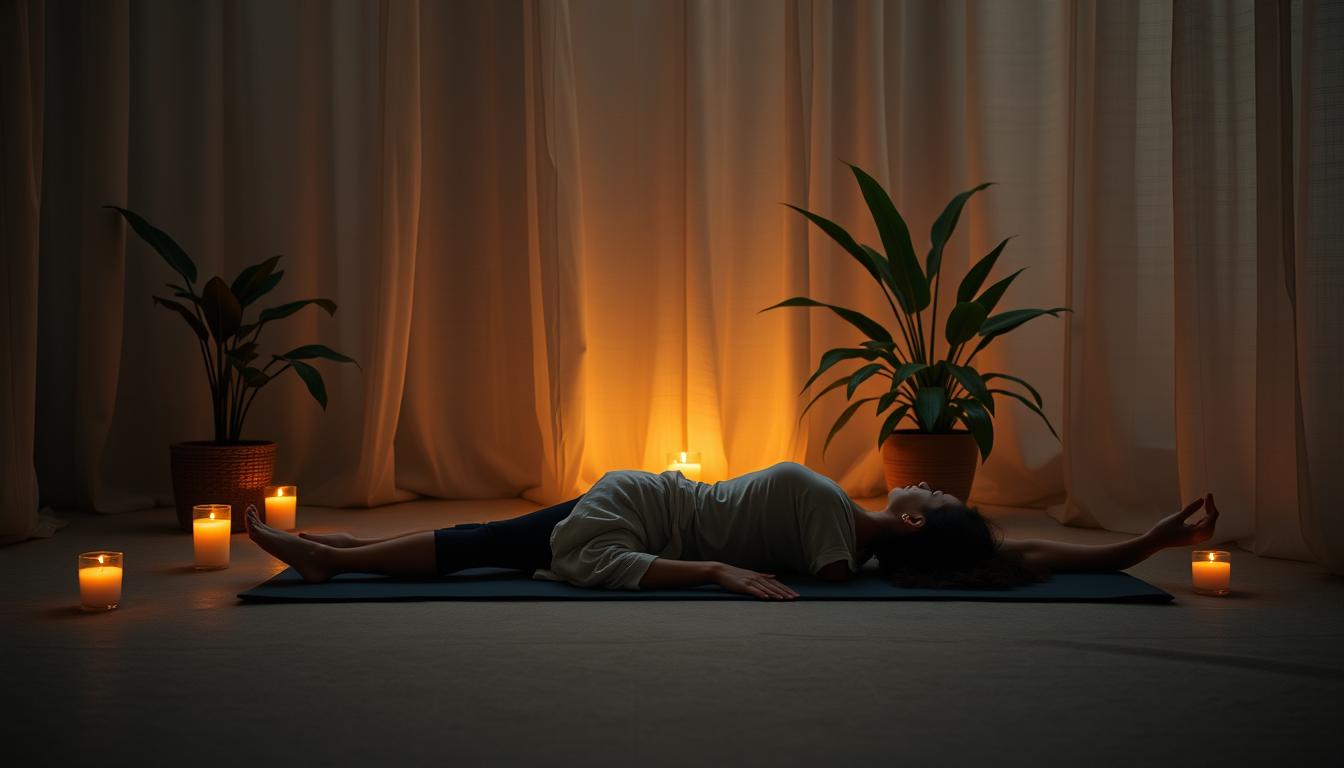“When you own your breath, nobody can steal your peace.” – Unknown
In today’s fast world, we all need ways to relax. Yoga Nidra is a powerful tool for deep relaxation. It calms your mind and body, leading to a peaceful state.
Yoga Nidra is more than meditation. It takes you on a journey through different levels of consciousness. It helps you relax deeply and feel refreshed.
Key Takeaways
- Yoga Nidra is a powerful relaxation technique that reduces stress and anxiety
- It activates the parasympathetic nervous system, counteracting the body’s stress response
- Yoga Nidra has been scientifically proven to enhance creativity, improve sleep, and promote positive physiological changes
- The practice can be adapted to fit your schedule, with sessions ranging from 2 minutes to 45 minutes
- Yoga Nidra is a versatile tool that can be easily incorporated into your daily routine
Understanding the Science Behind Yoga Nidra
Yoga Nidra is a mind-body practice that uses the parasympathetic nervous system’s power. It brings deep relaxation, easing anxiety disorders effects. Knowing how Yoga Nidra works can help you experience deep stress relief.
The Role of the Parasympathetic Nervous System
Yoga Nidra activates the parasympathetic nervous system, or “rest and digest” system. This lowers heart rate, breathing, and blood pressure. It also reduces muscle tension and stress hormones.
This deep relaxation is the opposite of the “fight-or-flight” response. It’s triggered by the sympathetic nervous system during stress.
How Stress Affects Your Body and Mind
Stress activates the sympathetic nervous system, raising heart rate and blood pressure. This can harm your physical and mental health, causing anxiety, depression, and insomnia. Yoga Nidra reverses this, promoting deep relaxation and stress reduction.
The Neuroscience of Deep Relaxation
Research shows Yoga Nidra changes brain activity and neurotransmitter levels. It increases endorphins, serotonin, and dopamine, leading to calm and well-being. This highlights Yoga Nidra’s deep impact on mental and emotional health.

“Yoga Nidra is a powerful tool for reducing anxiety and promoting deep relaxation. The science behind it shows how this ancient practice can profoundly impact your mind and body.”
What Makes Yoga Nidra Different from Traditional Meditation
Yoga Nidra is a special form of guided relaxation. It helps reduce stress and anxiety. You lie down and follow instructions to enter a deep sleep-like state. This is harder to do with just sitting meditation.
Yoga Nidra and meditation both aim to improve your mental and physical health. But they do it in different ways. Meditation focuses on being mindful and calm, while you sit up. Yoga Nidra uses guided images and body scans to deeply relax you.
A study showed Yoga Nidra is better at reducing stress than sitting meditation for college professors. After just 45 minutes, people felt as refreshed as after a three-hour nap.
Yoga Nidra can help you sleep better, focus more, and feel emotionally balanced. Meditation, however, boosts mindfulness and self-awareness. It helps you connect with yourself and others.
Choosing between Yoga Nidra and meditation depends on what you want. Both use relaxation techniques and mindfulness meditation. But Yoga Nidra is special for deep rest and stress relief.

Adding Yoga Nidra or meditation to your life can greatly benefit you. Try different methods to find what works best for you. This way, you can enjoy deep relaxation and inner peace.
The Powerful Benefits of Yoga Nidra for Stress and Anxiety Relief
Yoga nidra can change your life by helping with stress management, anxiety disorders, and better sleep quality. This ancient practice relaxes your body and mind deeply. It brings many physical, mental, and emotional benefits.
Physical Health Benefits
Yoga nidra can greatly reduce stress and anxiety. It boosts your immune system, lowers blood pressure, and relaxes muscles. A 2012 study showed it also relieves joint pain and swelling.
Mental and Emotional Benefits
Yoga nidra boosts creativity, focus, and self-awareness. It makes you feel calmer and helps manage emotions better. A 2018 study found it’s better than meditation for anxiety symptoms.
Sleep Quality Improvements
Yoga nidra greatly improves sleep quality. It helps you fall asleep faster and sleep longer. The National Sleep Foundation says adults need seven to nine hours of sleep each night.
“Yoga nidra has been scientifically shown to enhance creativity, improve sleep quality and memory, and induce positive physiological changes in red blood cell counts, blood glucose levels, and hormonal status.”
If you’re dealing with stress, anxiety, or poor sleep quality, yoga nidra can help. It’s a powerful tool for better well-being.
Essential Preparations for Your Yoga Nidra Practice
Getting the right mindset and setting the right environment is crucial for relaxation techniques like Yoga Nidra. Before starting, make sure you’re ready for deep mindfulness meditation.
Start by finding a comfy spot to relax. You could lie down, sit in a chair, or even stand. Choose a position that feels natural and keeps your spine straight.
Then, think about what you want to achieve. Maybe you want to reduce stress or sleep better. Having a goal helps focus your practice.
Make sure you’re in a quiet, distraction-free spot. Dim the lights, light candles, and play calming music or nature sounds. This will help create a peaceful atmosphere.
- Prepare your body and mind for deep relaxation
- Set a clear intention to focus your practice
- Cultivate a calm, peaceful environment for your session
With these steps, you’re ready to enjoy Yoga Nidra’s benefits. Let go and fully immerse yourself in the experience.
Creating the Perfect Environment for Deep Rest
Creating a calm and peaceful space is crucial for deep rest and relaxation through Yoga Nidra. By setting up your practice area, you can improve your experience. This makes the most of this powerful technique.
Setting Up Your Space
Find a quiet, comfy spot away from distractions. It should have little light and noise. This lets your mind dive deep into the practice.
Use blackout curtains or an eye pillow for privacy and to block out light.
Optimal Time for Practice
Evening is often the best time for Yoga Nidra, as it helps sleep and brings calm. But, the best time varies for everyone. Try different times to see what works best for you.
Required Props and Materials
- Yoga mat or a firm surface to lie on
- Blankets, pillows, or bolsters for support and warmth
- Eye pillow or sleep mask to block out light
- Aromatherapy oils or diffuser (optional) to enhance relaxation
These props and materials help create a cozy space for Yoga Nidra. Try different setups to find what suits you best.
“Yoga Nidra moves us through each layer of our being—physical, mental, energetic, intuitive, and spiritual—allowing us to experience inner peace.” – Karla Helbert, internationally certified yoga therapist
Step-by-Step Guide to Yoga Nidra Practice
Yoga Nidra is a powerful way to relax and reduce stress. It’s a mind-body practice that can change your life. This guide will help you start or deepen your practice, leading to inner peace and healing.
- Set an Intention: Start by setting a clear intention or sankalpa. This could be a positive affirmation or a goal, like “I am calm and centered” or “I am able to manage my stress effectively.”
- Body Scan: Lie down comfortably and focus on your body. Scan from toes to head, noticing sensations and tension.
- Breath Awareness: Pay attention to your breath. Breathe deeply, feeling your belly rise and fall.
- Guided Visualization: Continue breathing deeply and imagine a peaceful scene. It could be a serene beach or a lush forest. Use all your senses to immerse yourself in this imaginary world.
Yoga Nidra usually lasts 20-45 minutes. But even 10-15 minutes can be very beneficial. Regular practice can lead to deep relaxation, better sleep, and emotional well-being.
“Yoga Nidra is a state of consciousness between waking and sleeping, like the “going-to-sleep” stage. It is a state in which the body is completely relaxed, and the mind becomes systematically and increasingly aware.” – Swami Satyananda Saraswati
Yoga Nidra can be tailored to your needs. Try different visualizations, lengths, and frequencies to find what works best for you. Embrace the journey and let Yoga Nidra help you manage stress and improve your well-being.
Integrating Yoga Nidra into Your Daily Routine
Adding Yoga Nidra to your daily life can greatly reduce stress and help you relax. It’s more than just a quick break. Regular Yoga Nidra can deeply improve your well-being.
Morning vs Evening Practice
Choose when to practice Yoga Nidra based on what you need. Morning sessions can make your day calm and focused. Evening practices can help you sleep better and relax before bed. Try both to see what suits you best.
Duration and Frequency Recommendations
Practice Yoga Nidra daily, even if it’s just for a few minutes. Begin with 10-15 minutes and increase as you get more comfortable. Being consistent is crucial for Yoga Nidra’s benefits, like less stress, better sleep, and emotional health.
| Benefit | Impact |
|---|---|
| Stress Management | Yoga Nidra can greatly lower stress and anxiety, making you feel calmer and more resilient. |
| Sleep Quality | Regular Yoga Nidra can improve sleep, boosting mood, energy, and overall health. |
| Immune Function | Yoga Nidra reduces stress and promotes relaxation, boosting your immune system. |
| Self-Awareness | Yoga Nidra increases self-awareness and mindfulness, giving you deeper insights into yourself. |
Adding Yoga Nidra to your daily routine is a great way to handle stress management and use relaxation techniques. Whether morning or evening, the important thing is to be regular and fully engage. With regular practice, you’ll see the amazing changes Yoga Nidra can bring.
Common Challenges and How to Overcome Them
Starting your mindfulness meditation journey with Yoga Nidra can change your life. But, you might face some hurdles. Don’t worry, with the right strategies, you can beat these challenges and enjoy all Yoga Nidra has to offer for stress management.
Staying Awake During Practice
Falling asleep during Yoga Nidra is common and a good sign. It shows you’re relaxing deeply. To stay awake, try sitting instead of lying down. This keeps you alert while still enjoying deep relaxation.
Taming a Wandering Mind
It’s normal for your mind to wander during meditation. In Yoga Nidra, it can be hard to stay focused. If your mind strays, gently bring it back to the guide. With time, you’ll get better at staying focused, making the practice more effective.
Finding Time for Regular Practice
Being consistent with Yoga Nidra is important, but finding time can be tough. To make it a habit, set a regular time each day. It could be early morning or before bed. If you’re short on time, start with shorter sessions and grow them as you get more comfortable.
| Common Challenge | Solution |
|---|---|
| Falling asleep during practice | Practice in a seated position |
| Wandering mind | Gently bring focus back to the guided instructions |
| Lack of time for regular practice | Schedule practice at the same time each day, start with shorter sessions |
By facing these challenges with mindfulness and patience, you’ll find Yoga Nidra’s benefits. Commit to your practice and let Yoga Nidra lead you to deeper relaxation and self-discovery.
Advanced Techniques for Deeper Relaxation
As you get better at Yoga Nidra, you can try more advanced methods. These include powerful visualization, working with Sankalpa (intention), and detailed body scanning.
Visualization Methods
Visualization is a strong tool in Yoga Nidra. You might picture healing light or a calm natural scene. Guided imagery can really bring out feelings and sensations.
Working with Sankalpa (Intention)
Sankalpa, or a heartfelt intention, can change your Yoga Nidra practice. It helps you understand yourself better and grow. This mind-body practice can guide you towards positive life changes.
Body Scanning Techniques
Advanced body scanning in Yoga Nidra focuses on energy or sensation in your body. This can lead to deep relaxation and a stronger connection with yourself. Trying these techniques can make your Yoga Nidra practice even more powerful.
Remember, the secret to getting the most from Yoga Nidra is to be open-minded. By using these advanced techniques, you can relax deeper and discover more about yourself. This can lead to better well-being and personal growth.
Conclusion
Yoga Nidra is a powerful tool for managing stress and anxiety. It promotes deep relaxation and improves overall well-being. Regular practice can lead to better physical and mental health, sleep, and emotional balance.
Adding Yoga Nidra to your daily routine can bring calm and resilience. It’s great for those seeking relief from modern life or wanting to deepen their spiritual practice. Yoga Nidra is an accessible and effective way to relax and rejuvenate.
Start embracing Yoga Nidra’s transformative power. With regular practice, you’ll feel more centered and focused. You’ll be able to handle life’s ups and downs with ease. Begin your journey of self-discovery and tap into Yoga Nidra’s benefits for stress relief and relaxation.
FAQ
What is Yoga Nidra and how does it work?
Yoga Nidra is a deep relaxation technique. It balances your mind and improves your emotional health. It calms your nervous system, reducing stress and heart rate.
How is Yoga Nidra different from traditional meditation?
Yoga Nidra is done lying down and involves guided visualizations. It’s a way to relax deeply while staying awake.
What are the benefits of practicing Yoga Nidra?
Yoga Nidra can lower stress and anxiety. It improves sleep and boosts your immune system. It also increases self-awareness and creativity.
How should I prepare for a Yoga Nidra practice?
Find a comfy spot to relax. Set an intention and choose a quiet space. This helps you focus on your practice.
What steps are involved in a typical Yoga Nidra practice?
A typical practice includes setting an intention and a body scan. It also involves breath awareness and guided visualization. Sessions last 20-45 minutes.
How often should I practice Yoga Nidra?
Practice Yoga Nidra daily, even for just a few minutes. Morning practice sets a calm tone. Evening practice helps with sleep. Start with 10-15 minutes and increase as you get more comfortable.
What are some common challenges in Yoga Nidra practice?
Challenges include staying awake and finding time. Try sitting instead of lying down. Schedule your practice at the same time each day.
What are some advanced Yoga Nidra techniques?
Advanced techniques include complex visualizations and Sankalpa. They also involve subtle body scans. These techniques deepen relaxation and transformation.




























































